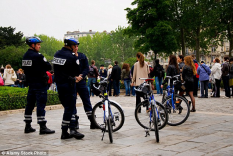
Most European pickpockets(扒手) work in groups and use distraction methods to rob unsuspecting tourists at popular attractions. Chief marketing officer for TripAdvisor Christine Peterson said, “Not always a basic ‘lift-and-run’ operation, now expert pickpocketing can sometimes involve more complicated tricks. Travelers need to be aware of all kinds of tricks meant to distract them from their belongings while enjoying popular world attractions.”
Here are some European cities that according to TripAdvisor are places to be especially aware of pickpockets.
Barcelona
With its impressive Catalan architecture and perfect coastline, it is no wonder Barcelona is one of Europe’s top tourist destinations. But more than 300 thefts are reported every day in this spectacular city, earning itself the reputation as the pickpocket capital of the world.
You can become a victim anywhere in Barcelona, but thieves particularly target Cathedral Square, Las Ramblas, Plaza Catalunya and Plaza Real.
Paris
Paris is one of the world’s most visited cities, but the tourist attractions which make the “city of love” famous are teeming with pickpockets.
The Eiffel Tower was closed for a day last year after staff went on strike demanding help to deal with thieves operating around the landmark. The Louvre, the world’s most visited museum, was closed in 2013 also because of strikes related to pickpockets targeting tourists and employees.
Madrid
As a Spanish city famous for tourism, Madrid is home to the infamous “Bosnian clan”.
Four women who form the infamous pickpocket gang(团伙) made a name for themselves in Barcelona—where they robbed thousands of tourists and Metro users—before moving on to Madrid.
In 2013 the gang was banned from all of Madrid’s underground network, before the ban was overturned(推翻) on a legal detail. Pickpocketing on the Madrid Metro dropped by 40 per cent while the ban was in place.
The Metro, the Plaza Mayor and Cibeles Square are prime target areas for Madrid’s thieves.
本时文内容由奇速英语国际教育研究院原创编写,禁止复制和任何商业用途,版权所有,侵权必究!
1.What’s the passage mainly about?
A Advice on how to keep away from pickpockets.
B Pickpockets use complicated ways to steal from tourists.
C Several European cities where you may fall victims of thieves.
D Tourists may have their money stolen in popular attractions.
解析:选C。主旨大意题。根据文章第一、二段可知,本文主要介绍了几个扒手猖獗的欧洲城市的情况,故选C。
2.What did thieves usually do in the past?
A They ran away immediately after stealing.
B They used some complicated ways to cheat.
C They worked alone to rob unsuspecting tourists.
D They enjoyed popular world attractions with people.
解析:选A。细节理解题。根据文章第一段Not always a basic “lift-and-run” operation, expert pickpocketing can sometimes involve more complicated tricks可知,扒手过去是偷了就跑,而现在则比较老道,使用复杂的手段分散游客的注意力,趁乱下手,故选A。
3.What do the underlined words “teeming with” in Paragraph Five mean?
A Filled with.
B Working with.
C Meeting with.
D Coping with.
解析:选A。词义猜测题。根据下文埃菲尔铁塔和卢浮宫扒手泛滥的语境可知,teem with 意为“满是,都是”,故选A。
4.What can we infer from the passage?
A Overturning the ban to the pickpocket gang meant to encourage them.
B It was not right to abolish the ban on the pickpocket gang to take Madrid Metro.
C Tourists might have their money stolen in museums or on squares in Europe.
D The European countries seem to have no way to fight against pickpockets.
解析:选B。B推理判断题。根据文章倒数第二段“Pickpocketing on the Madrid Metro dropped by 40 per cent while the ban was in place”可知,这个扒手团伙不得乘坐地铁的禁令在实施期间失窃率下降了40%,但是取消这个禁令之后失窃率反弹,由此判断,取消这个禁令的做法并不合理,故选B。